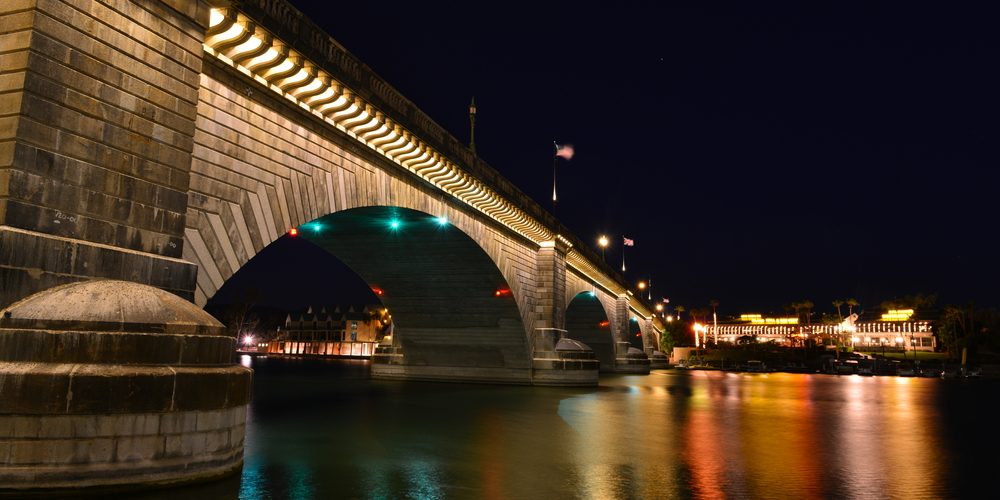Learn about the legendary structure and how Bridge Masters, Inc., is helping facilitate its celebration.
London Bridge is a famous structure that was built in the 1830s. It crossed the Thames River in the city of London.
So, why is Bridge Masters taking on a project for it in Lake Havasu City, Arizona?
It’s related to a long and fascinating story of a bridge that was purchased and taken, brick by brick, halfway around the world. Here’s the tale of how the London Bridge came to be moved from its original home in London to Arizona, along with how Bridge Masters ended up working on it.
History of the London Bridge
The original 1831 London Bridge was the final project of the legendary engineer John Rennie. He passed away during construction and work was completed by his son. The notable bridge stayed in use until 1962, when it was found to be not sturdy enough to carry the current traffic load. The city of London decided to sell the structure to make way for a replacement.
The bridge was purchased by Robert P. McColloch from the City of London in 1968.
The eccentric entrepreneur and real estate developer was establishing a planned community on the shore of Lake Havasu in Arizona. He wanted to create an island on the lake and connect it to the main part of Lake Havasu City. He decided to use the London Bridge to do so. He purchased, moved, and installed the bridge and built an English village near it as a publicity stunt to attract tourists and retirement home buyers to his new development.
The “new” London Bridge was completed in 1971. The bridge is a new version of the old structure. It combines a modern reinforced concrete substructure with the original masonry of the 1830s bridge. The London Bridge was officially rededicated in Arizona on October 10, 1971.
Did you know: There is a popular rumor that McColloch bought the London Bridge by mistake, thinking it was the more recognizable Tower Bridge? The story has been denied by all the parties involved in the sale.
Moving the London Bridge
Each facing stone of the original London Bridge was individually removed and numbered and its position catalogued, so it could be reinstalled on the bridge in the new location. The stones were then shipped to a quarry in Merrivale, Devon. Approximately six to eight inches were removed from the inside faces of the stones so they would fit over the new, reinforced substructure.
How did the stones finally make it to the United States? A cargo shipping company at the time was planning to sail a newly built ship, without any cargo, to the U.S. The parties involved negotiated that the new owners of the bridge would pay for the operating costs of the voyage in return for the shipping company carrying the stone facings to the United States for no charge. This resulted in significant savings because the heavy stones would have cost a great deal of money to ship.
The ship traveled through the Panama Canal, and the stones were unloaded in Long Beach, California. From there, they were transported over land to Lake Havasu City. The facings began to be applied in 1968.
Did you know London Bridge has played a major role in many movies?
- The 1983 psycho thriller, “Olivia,” leveraged the relocation of the London Bridge as a key plot device.
- The 1985 made-for-television movie, “A Bridge Across Time,” another thriller, featured the bridge. In the film, the spirit of Jack the Ripper was transported to 1980s Arizona along with the London Bridge, resulting in a murder spree.
- The structure was also featured in the 1987 film, “Million Dollar Mystery” and the television series, “Ghost Adventures.
Reconstructing the London Bridge in Lake Havasu
The original foundation stone of the London Bridge was re-laid at the new site on September 23, 1968, by Sir Gilbert Inglefield, Lord Mayor of London. The reconstruction, which was handled by Sundt Construction, took a little more than three years and was finished in late 1971.
The bridge was not reconstructed over a river. Instead, it now connects the main section of the city of Lake Havasu with the Pittsburgh Point peninsula over Lake Havasu. After the bridge was completed, a canal was dug that turned the peninsula into an island.
London Bridge as a tourist attraction
Once the bridge was in place, it and the English village built around it became a notable tourist attraction. People who came to see it stayed in local hotels and toured the properties that were for sale. Land sales in the new Lake Havasu community took off, and the expense of purchasing and shipping the bridge was paid off. Lake Havasu eventually became a successful community and tourist destination.
Unfortunately, the original English village, which was an open air mall, garden, and museum, fell into disrepair, and much of it has been leveled. A single building from it survives as a visitor center.
Bridge Masters, Inc.’s work
It’s true that the London Bridge could use some extra help. For about a decade, it has been rated as functionally obsolete. That means it’s not able to handle the traffic that it currently does as safely and efficiently as possible. London Bridge has to be inspected frequently to make sure it’s still safe and structurally sound.
For this project, however, Bridge Masters, Inc. was commissioned to add some LED lights using our Bridge Walker I Machine to help them commemorate the 50th anniversary of the bridge with a light show.


